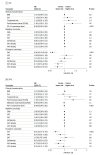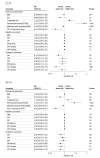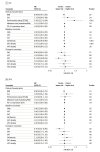Body Composition in Advanced Non-Small Cell Lung Cancer Treated With Immunotherapy
- PMID: 38780929
- PMCID: PMC11117154
- DOI: 10.1001/jamaoncol.2024.1120
Body Composition in Advanced Non-Small Cell Lung Cancer Treated With Immunotherapy
Abstract
Importance: The association between body composition (BC) and cancer outcomes is complex and incompletely understood. Previous research in non-small-cell lung cancer (NSCLC) has been limited to small, single-institution studies and yielded promising, albeit heterogeneous, results.
Objectives: To evaluate the association of BC with oncologic outcomes in patients receiving immunotherapy for advanced or metastatic NSCLC.
Design, setting, and participants: This comprehensive multicohort analysis included clinical data from cohorts receiving treatment at the Dana-Farber Brigham Cancer Center (DFBCC) who received immunotherapy given alone or in combination with chemotherapy and prospectively collected data from the phase 1/2 Study 1108 and the chemotherapy arm of the phase 3 MYSTIC trial. Baseline and follow-up computed tomography (CT) scans were collected and analyzed using deep neural networks for automatic L3 slice selection and body compartment segmentation (skeletal muscle [SM], subcutaneous adipose tissue [SAT], and visceral adipose tissue). Outcomes were compared based on baseline BC measures or their change at the first follow-up scan. The data were analyzed between July 2022 and April 2023.
Main outcomes and measures: Hazard ratios (HRs) for the association of BC measurements with overall survival (OS) and progression-free survival (PFS).
Results: A total of 1791 patients (878 women [49%]) with NSCLC were analyzed, of whom 487 (27.2%) received chemoimmunotherapy at DFBCC (DFBCC-CIO), 825 (46.1%) received ICI monotherapy at DFBCC (DFBCC-IO), 222 (12.4%) were treated with durvalumab monotherapy on Study 1108, and 257 (14.3%) were treated with chemotherapy on MYSTIC; median (IQR) ages were 65 (58-74), 66 (57-71), 65 (26-87), and 63 (30-84) years, respectively. A loss in SM mass, as indicated by a change in the L3 SM area, was associated with worse oncologic outcome across patient groups (HR, 0.59 [95% CI, 0.43-0.81] and 0.61 [95% CI, 0.47-0.79] for OS and PFS, respectively, in DFBCC-CIO; HR, 0.74 [95% CI, 0.60-0.91] for OS in DFBCC-IO; HR, 0.46 [95% CI, 0.33-0.64] and 0.47 [95% CI, 0.34-0.64] for OS and PFS, respectively, in Study 1108; HR, 0.76 [95% CI, 0.61-0.96] for PFS in the MYSTIC trial). This association was most prominent among male patients, with a nonsignificant association among female patients in the MYSTIC trial and DFBCC-CIO cohorts on Kaplan-Meier analysis. An increase of more than 5% in SAT density, as quantified by the average CT attenuation in Hounsfield units of the SAT compartment, was associated with poorer OS in 3 patient cohorts (HR, 0.61 [95% CI, 0.43-0.86] for DFBCC-CIO; HR, 0.62 [95% CI, 0.49-0.79] for DFBCC-IO; and HR, 0.56 [95% CI, 0.40-0.77] for Study 1108). The change in SAT density was also associated with PFS for DFBCC-CIO (HR, 0.73; 95% CI, 0.54-0.97). This was primarily observed in female patients on Kaplan-Meier analysis.
Conclusions and relevance: The results of this multicohort study suggest that loss in SM mass during systemic therapy for NSCLC is a marker of poor outcomes, especially in male patients. SAT density changes are also associated with prognosis, particularly in female patients. Automated CT-derived BC measurements should be considered in determining NSCLC prognosis.
Conflict of interest statement
Figures





References
-
- Maurits JSF, Sedelaar JPM, Mulders PFA, Aben KKH, Kiemeney LALM, Vrieling A. Skeletal muscle radiodensity and visceral adipose tissue index are associated with survival in renal cell cancer—a multicenter population-based cohort study. Clin Nutr. 2022;41(1):131-143. doi:10.1016/j.clnu.2021.11.012 - DOI - PubMed
-
- Pickhardt PJ, Graffy PM, Zea R, et al. . Automated CT biomarkers for opportunistic prediction of future cardiovascular events and mortality in an asymptomatic screening population: a retrospective cohort study. Lancet Digit Health. 2020;2(4):e192-e200. doi:10.1016/S2589-7500(20)30025-X - DOI - PMC - PubMed
MeSH terms
LinkOut - more resources
Full Text Sources
Medical
Research Materials
Miscellaneous

